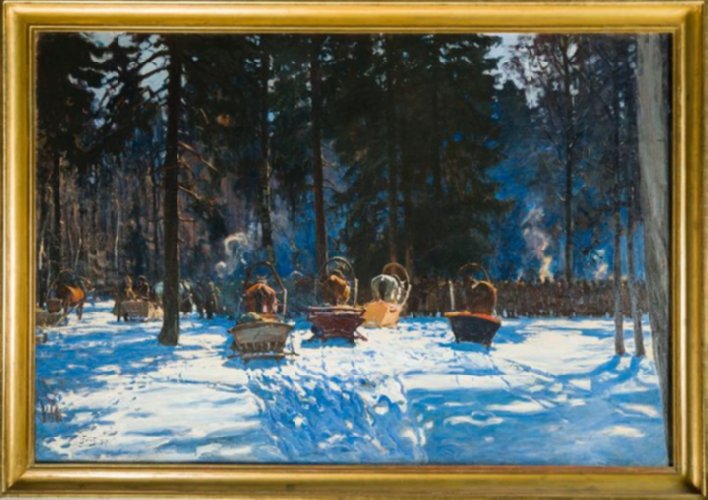Description:
Julian Fałat (1853-1929) studied at the Krakow School of Fine Arts and in Munich. He came from a peasant family, which shaped his artistic path. He became recognizable as an aquarellist, because as a poor student he chose the cheaper painting technique. He is also known as the “painter of hunts” because he held this role for ten years at the court of Emperor Wilhelm II. In 1895 he became the director of the Krakow School of Fine Arts, which, thanks to him, became an academy.
The description of the painting:
In 1886 Julian Fałat received an order to paint the documentation of the hunt of Anton Radziwiłł with the Emperor Wilhelm II. The order turned out to be the beginning of Fałat’s career as a hunting painter, with which he is still mainly associated. During the hunt, Henryk Sienkiewicz said to a friend: “You know, it’s amazing! I’m just haunted by Fałat here! I have to think about him all the time and I see his pictures.” Unlike other artists painting hunts, such as Kossak or Chełmoński, Fałat rarely showed typical, dynamic shots, dead game, horse chase or barking dogs. His paintings portrayed hunters from a distance, with a constantly new and interesting perspective. He did not embellish or dramatize the composition, but showed the reality of hunts, which also included waiting, resting or returning with game. He rarely showed wounded animals and decisive moments of the chase.
This is also the case in the painting “The Hunt”, where no dynamic chase can be seen, but only the backs of the sleds and a large group of people standing peacefully by the campfire in the distance. Most of the space is occupied by the foreground snow and the rhythmic strip of forest in the background. The whiteness of the snow is highlighted by the contrasting blue shades cast by the trees around it, and the furrows created by the sleds. It is difficult to find any element of the chase suggested by its theme in the painting. The painter observes the scene from a great distance, as if he himself did not want to take part in it, presenting its background, the waiting hunters. The theme in the painting seems to be secondary, not as important as the light breaking from white to blues and navy blue on the snow, or the blue-gray smoke rising between the trees. This light and color, as well as nature, seem to be the most important theme fascinating the painter.
In the year the “The Hunt” was created, Fałat painted a whole series of winter landscapes. They show snowy wastelands crossed by streams of cold water. In the discussed painting, the artist also focuses more on observing the nature around him than on the hunt in the distance, which he paints as if incidentally. In 1907 he is already a mature artist, whose experience and path in his professional and private life are reflected in his canvases. He took up painting hunting scenes for financial reasons. However, nature fascinated him since childhood, which he spent in the countryside. When in 1895 he became the director of the School of Fine Arts in Krakow, he introduced the landscape department with Jan Stanisławski, a landscape artist at the helm, which was a novelty and a change of direction of the School previously managed by Jan Matejko. The painting “The Hunt” is therefore a combination of Fałat’s artistic search and his paid work, which he was famous for.


